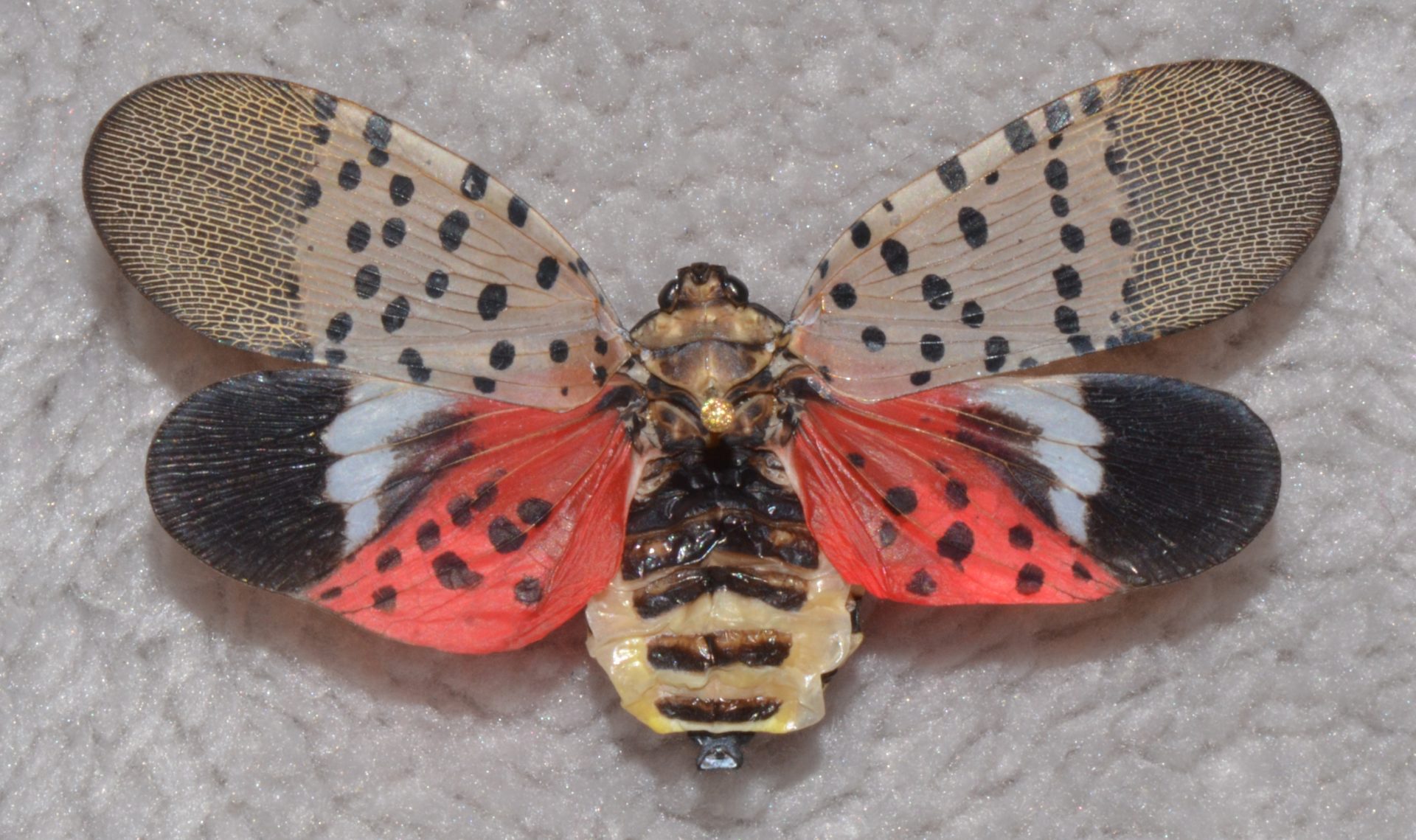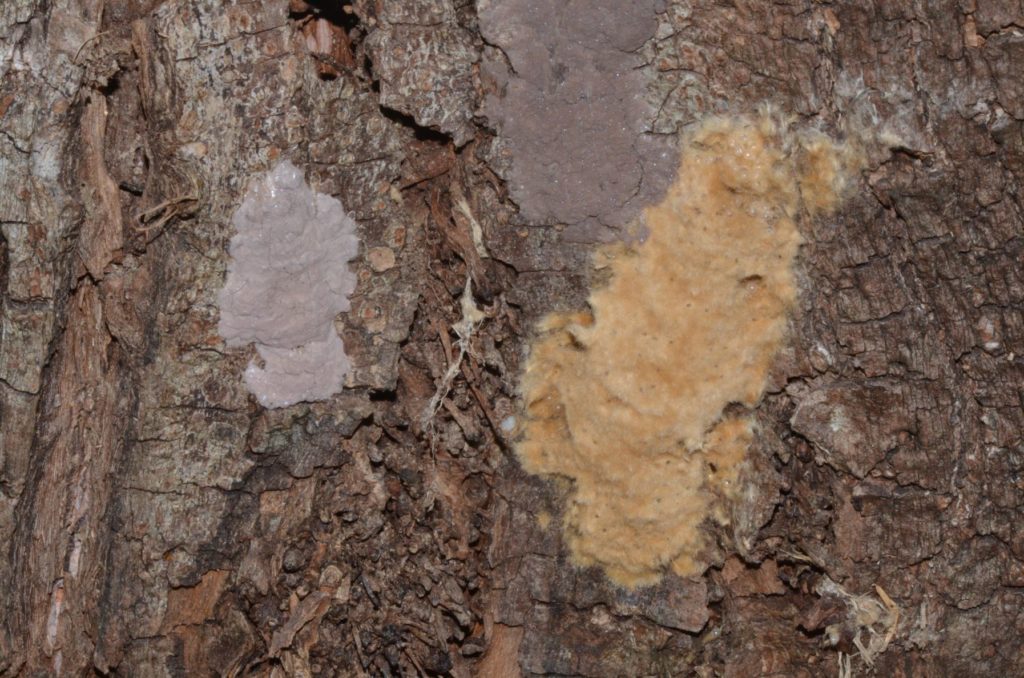By Tawny Simisky
The MA Department of Agricultural Resources (MDAR) announced on September 28, 2021, that a small, established, and breeding population of the invasive spotted lanternfly (Lycorma delicatula) was detected in Worcester County, MA, in the city of Fitchburg. State officials confirmed these findings.
For further details regarding what is known about the population in Fitchburg, MA and MDAR’s response, visit the press release: State Agricultural Officials Discover Invasive Spotted Lanternfly Population in Worcester County.

Adult spotted lanternfly with wings spread open. ( Photo Courtesy of Gregory Hoover.)
What Should You Do?
Residents and professionals living and working across the Commonwealth should learn the life stages of the spotted lanternfly and be able to identify their eggs, immatures, and adults. (Read below for reporting outside of Massachusetts.) At this time, it is particularly valuable to learn how to ID spotted lanternfly adults and egg masses. If any life stages of this insect are found in Massachusetts, report them immediately here: Spotted Lanternfly Report Reporting Form – Massachusetts Introduced Pests Outreach Project.
Adults may be seen until after the first couple of hard frosts. Egg masses may be seen overwintering on just about any flat surface, including but not limited to: host plants, firewood, live plants for sale, fences, stone, outdoor furniture and structures, vehicles, and much more.
In particular, if you know of the tree of heaven (Ailanthus altissima)1 growing nearby, check that preferred host for adults and egg masses and report anything suspicious to the aforementioned website. That said, spotted lanternfly adults and eggs masses (and immatures when active) may be found just about anywhere. (Other preferred hosts include grapevines, maple, and walnut trees.)
1The tree of heaven is a rapidly growing deciduous tree native to China and Taiwan that has become a widespread invasive species across North America. Learn how to identify this invasive tree here: Tree-of-Heaven – Penn State Articles.

Two spotted lanternfly egg masses (gray in color and to the upper left and center of the photo) next to a single tan/brown Lymantria dispar (formerly known as gypsy moth) egg mass. ( Photo Courtesy of Gregory Hoover.)
Should You Treat?
At this time, the only established (breeding) population of spotted lanternfly in Massachusetts is in a small area of Fitchburg, MA. Therefore, there is no reason to be preemptively treating for this insect in other areas of the Commonwealth at the time this article was written. If you suspect you have found spotted lanternfly in additional locations, please report it immediately to MDAR at the link provided above. If you live and work in the Fitchburg area, please be vigilant and continue to report anything suspicious.
What Is at Risk?
The spotted lanternfly feeds on over 103 different species of plants, including agriculturally significant crops (apple, peach, grape, etc.) and trees and shrubs that are important in our managed landscapes and natural areas. Due to various factors, spotted lanternflies are also a significant public nuisance once they become established.
Spotted lanternfly individuals often gather in large groups, so once a population builds in size, hundreds and sometimes thousands of insects can be found on a single tree. SLF uses piercing-sucking mouthparts to feed on their host plants, removing sap. The sugary secretions (excrement) created by this insect may coat the host plant, later leading to the growth of sooty mold, which appears black in color. Insects such as wasps, hornets, bees, and ants may also be attracted to the sugary waste created by the lanternflies or sap weeping from open wounds in the host plant.
For More Information:
From UMass Extension: Landscape: Spotted Lanternfly | Center for Agriculture, Food, and the Environment at UMass Amherst
From the MA Department of Agricultural Resources:
Spotted Lanternfly – Lycorma delicatula
Nursery Best Management Practices (January 2021)
Checklist for Residents in or near Infested Areas
Driver’s Checklist in English or Spanish (September 2021)
Moving Industry Checklist (February 2021)
Living or Working Outside of Massachusetts?
If you live or work outside of MA and are looking to report what you believe to be a spotted lanternfly locally, please reach out to either your State’s department of agriculture or forestry, the USDA-APHIS, or your local Extension office. The following may be helpful resources in New England:
To find the USDA-APHIS State Plant Health Director for your State: State Plant Health Directors
Additional State Resources:
Maine: Maine.Gov Got Pests?
Vermont: Vermont Invasives: Home
New Hampshire: Reporting Form | NHBugs
Connecticut: Connecticut State The Connecticut Agricultural Experiment Station
Rhode Island: Pest Alerts- Rhode Island -Department of Environmental Management
About the Author
Tawny Simisky is a Woody Ornamental Entomology Specialist with UMass Extension and the interim team leader of the Landscape, Nursery, and Urban Forestry Program. She develops resources and implements educational programs for landscape professionals, arborists, and grounds managers. She provides entomological and diagnostic support to the UMass Plant Diagnostics Lab. Prior to this position, she worked with the Massachusetts Department of Conservation and Recreation (DCR) Forest Health Program where she was involved with the eradication of the Asian longhorned beetle, monitoring the emerald ash borer, hemlock woolly adelgid, and other forest pests throughout the state. She earned her M.S. Degree in Ecology and Environmental Science with a focus on Entomology from the University of Maine, Orono. While at UMaine, her research focused on biosurveillance to monitor for the invasive emerald ash borer (Agrilus planipennis) using a native, ground-nesting and non-stinging wasp, Cerceris fumipennis, also known as the smoky-winged beetle bandit. Prior to her Masters’ work, Simisky earned both a Bachelors of Science in Biology and Environmental Science from Westfield State University in Westfield, MA.
***
Each author appearing herein retains original copyright. Right to reproduce or disseminate all material herein, including to Columbia University Library’s CAUSEWAY Project, is otherwise reserved by ELA. Please contact ELA for permission to reprint.
Mention of products is not intended to constitute endorsement. Opinions expressed in this newsletter article do not necessarily represent those of ELA’s directors, staff, or members.

